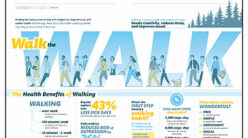It’s not unusual for people to feel that they can work out only if they have a fully equipped gym with a large assortment of equipment. Nothing could be further from the truth. The only things you need to work out are motivation and determination.
There are basically two parts to a workout–cardiovascular (or aerobics) and strengthening (or toning). Most people are under the impression that aerobic exercise should leave you gasping for air. The reality is that working out aerobically should actually feel quite comfortable. You can work out aerobically without equipment by (in order of difficulty):
Once you feel complacent walking and it becomes harder to reach that level of 6 or 7 exertion, you might want to “up the ante.” Go to your local park and add hills and even rocky terrain. Not only does this make walking a mile or two more difficult; it also allows you to burn more calories in the same amount of time. You’ll also be increasing your balance and coordination as you clamor over rocks and uneven ground. While you do this you’ll want your exertion to be at about the 6 to 8 level. You’ll find that the uphills will bring you close to your maximum aerobic peak, while the downhills and flats will be easier. Be aware of how you feel while walking the uphills, and don’t be afraid to stop and catch your breath.
For those of you looking to progress to a more advanced program, add some running. To do this, first begin by walking as your warmup. After about 10 to 15 minutes begin to run slowly for about 30 seconds to three minutes until you either get winded or reach level 8 in your perceived range of 1 to 10. Then drop your pace back down to a walk for three to six minutes until you catch your breath and feel comfortable. Again, begin to run slowly for about 30 seconds to three minutes. Continue with this pattern while you slowly work on extending the length that you are able to run. This type of progression is called interval training. The definition of interval training is periods of heavier aerobics intertwined with periods of lighter aerobics or what is called the recovery period. Your goal is eventually to be able to sustain your running for 20 minutes or more.
Resistance exercise is the other piece of the puzzle. You just need to challenge the muscles–not necessarily exhaust them. This can be done using iron dumbbells, expensive gym equipment, rubberized tubing, or even your own body weight. The exercises described below target the major “trouble spots” and use only your body weight and some simple household objects.
Back lunges
Starting with your feet together, step backward and plant one foot about two feetor so back. Both knees should be bent to about 90 degrees or less at this point. Bring the back foot forward to its starting position. Repeat with the other leg. You should feel this working your legs. Do eight to 12 repetitions on each side.
Tricep dips
Start by sitting on the very edge of a sturdy chair or firm sofa. Have your legs straight out in front of you and your hands on the front edge of the chair with your fingers pointed forward. Bring your seat over the front edge of the chair and bend your elbows to lower yourself down about six to eight inches. Straighten your arms to lift yourself back up. This will work the back of your arms. Do eight to 12 repetitions.
Pushups
These can be done with straight legs and your hands either on the floor or raised on something or by bending your legs and supporting yourself on your knees. You should feel this working your chest and the back of your arms. Do eight to 12 repetitions.
Sit-backs
Stand in front of a sofa or kitchen chair with your feet about 12 inches apart. Sit down and try to sit far back into the furniture. Without using your hands, stand up. (Hint: Kitchen chairs are easier than sofas.) You should feel this working the back of your legs. Do eight to 12 repetitions.
Crunches
A crunch is nothing more than a sit-up. Lying on your back with bent knees, place your hands in back of your head. Lift your shoulders off the ground without pulling on your head with your hands. You should feel this in your stomach. Do 10 to 50 repetitions.
As a rule of thumb, aerobic exercise should be done 20 to 30 minutes a day, three to four days a week. Toning exercises should be done twice a week.
The hardest part of any exercise program is just getting out the door and starting. If you’re having trouble starting, go for a 10-minute walk. Once you start walking, going for 20 or 30 minutes won’t be much harder. Toning exercises can be tackled one by one during the commercial breaks of your favorite television show. Since there are only five exercises and certainly more than five commercial breaks during a one-hour television program, they should be easy to complete right in your own living room. Remember, not every exercise has to be done every day, but the secret is to start. Good luck!







1 thought on “Workout Without Equipment”
lilly
(June 21, 2010 - 8:19 am)i totally agree. Trying to get fit doesn’t necessarily mean going to the gym.
Comments are closed.